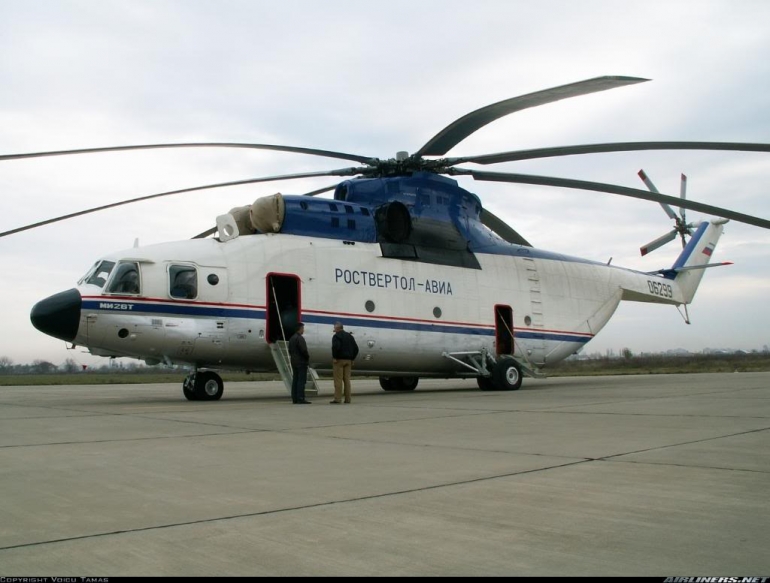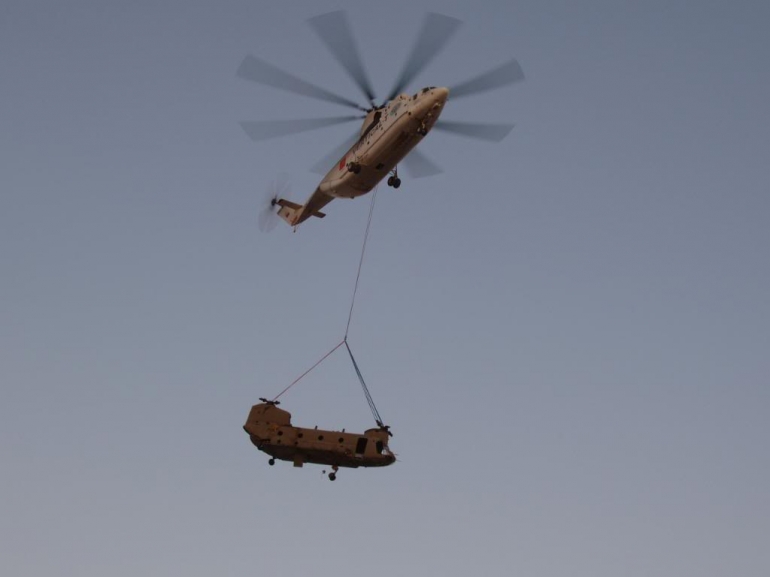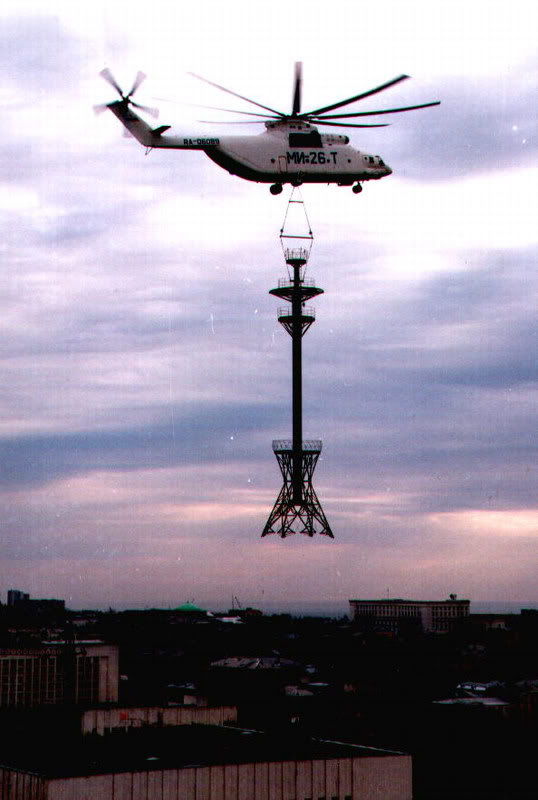TEKNOLOGI CANGGIH
Canggih #07
Helikopter Angkut Besar Mi-26T & MI-12 buatan Russia
Artikel Teknologi Canggih ini dimaksud untuk memberi motivasi kepada Pemerintah, Bangsa, dan Rakyat Indonesia, agar tergerak untuk memiliki dan menguasai Teknologi Canggih semacam ini. Memang hal ini adalah sebuah mimpi, tetapi mimpi yang bisa menjadi kenyataan, asal kita bisa menjalankan strategi yang benar dalam memajukan Bangsa dan Negara kita. Strategi jangka panjang yang baik harus disusun oleh ahli-ahli dan elit-elit kita, jangan elit-elit kita berantem melulu. Strategi untuk 30 tahun atau 50 tahun mendatang bagi Negara Indonesia yang kaya raya ini harus disusun, kalau undang-undang nya tidak memungkinkan untuk membuat strategi ini, ya undang-undangnya dirubah. Catatan : Karena Indonesia rawan dengan bencana alam terutama gempa bumi, maka sebenarnya Indonesia sangat memerlukan helikopter canggih semacam Mi-26 ini, yang mampu mengangkut peralatan berat ke daerah terisoler disebabkan oleh karena bencana alam, misalnya gempa bumi. Apabila kita memilikinya, pasti helikopter ini akan sangat membantu, yaitu bermanfaat untuk mengangkut bahan logistik berupa bantuan bahan makanan, obat-obatan, pakaian dan lain-lain, termasuk mengangkut alat berat yang sangat diperlukan untuk menolong korban yang tertimbun reruntuhan bangunan. Mi-26T
Mil Mi-26
The Mil Mi-26 (Russian Ми-26, NATO reporting name Halo) is a Soviet/Russian heavy transport helicopter in service in civilian and military roles. It is the biggest and most powerful helicopter ever to have gone into production.
Design and development
The Mi-26 was designed as a heavy-lift helicopter intended for military and civil use. It was designed to replace the earlier Mi-6 and Mi-12 heavy lift helicopters, with a design that had twice the cabin space and payload of the Mi-6, then the world's largest and fastest production helicopter. The primary purpose was to move military equipment such as 13 metric ton (29,000 lb) amphibious armored personnel carriers, as well as move mobile ballistic missiles to remote locations after delivery by military transport planes, such as an Antonov An-22 or Ilyushin Il-76. The helicopter was designed by Marat Tishchenko, protégé of Mikhail Mil, founder of the design bureau OKB Mil.[1] The first Mi-26 flew on 14 December 1977, and entered service in the Soviet military in 1983. The Mi-26 was the first helicopter equipped from the factory with an eight-blade rotor. It is capable of single-engine flight in the event of loss of power by one engine (depending on aircraft mission weight) because of an engine load sharing system. While it is only slightly heavier than the Mil Mi-6, it can lift up to 20 metric tons (44,000 lb) - 8 tons more than Mi-6. The Mi-26 is the second largest and heaviest helicopter ever constructed, following the experimental Mi-12.

Mil Mi-12
The Mil V-12 (also referred to as the Mi-12, NATO reporting name "Homer") is the largest helicopter ever built. The name "Mi-12" would have been the name for the production helicopter. Since the V-12 never went into production and only two prototypes were built, the name "Mi-12" was never adopted.[1]
Design and development
Development came about as a need for a heavy lift helicopter capable of carrying major missile components.[2] Production began on the V-12 prototype in 1965 with the goal of lifting no less than 30,000 kg. The first prototype made its first lift-off on 27 June 1967. After a few oscillations in close proximity to the ground the V-12 made a rough touchdown on one wheel resulting in a burst tire and a bent wheel disk. Even though the damage was insignificant, it was reported in the Western press that the prototype had suffered severe damage, and even to this day the rumor persists that the prototype had crashed fatally.[1] The V-12 features the only two-rotor transverse scheme ever built by Mil, eliminating the need for a tail rotor. The twin engines were taken together with the rotors from the Mil Mi-6 and duplicated on the V-12. Being the first time used by Mil, the twin rotor transverse scheme was not new. It was first seen in the Focke-Wulf Fw 61 the first fully controlable helicopter from 1936. Later, other helicopters used the scheme such as the Focke Achgelis Fa 223 Drache from 1940. The Soviet Kamov OKB built an experimental aircraft with the same scheme in 1958, Kamov Ka-22 Vintokryl. This aircraft had also the combined wing/rotor arrangement later used on the Mil V-12. The first prototype, now wearing the registration SSSR-21142, made its first flight on 10 July 1968, flying from the Mil factory pad in Panki to the Mil OKB test flight facility in Lyubertsy. In February 1969, the first prototype lifted a 31,030 kg payload to 2,951m (9,682 feet). On 6 August 1969, the V-12 lifted 44,205 kg (88,636 lb) to a height of 2,255m (7,398 feet), a world record. In May-June 1971 the first prototype V-12 SSSR-21142 made a series of flights over Europe being topped by the participation in the 29th Paris Air Show at Le Bourget wearing exhibit code H-833. The second prototype had been assembled at the Mil experimental production facility in Panki but sat in the workshop for a full year waiting for its engines. It was not until March 1973 that the second prototype could make its first flight, being from Panki to the flight test facilities in Lyubertsy. Curiously the second prototype was also registered SSSR-21142. The design outperformed its design specifications, set up numerous world records which still hold today, and brought its designers numerous awards such as the prestigious Sikorsky Prize awarded by the American Helicopter Society for outstanding achievements in helicopter technology. The V-12 design was recognized as an invention for which patents were issued in the USA, Great Britain and other countries. Despite all of these achievements the Soviet Air Force refused to accept the helicopter for state acceptance trials for many reasons, the main one being the fact that the initial purpose for which V-12 had been developed no longer existed, i.e., the rapid deployment of strategic ballistic missiles. In the meantime the military concept of deploying missiles had been altered since some of the missiles had proved disappointing and were phased out. This was the same reason which led to the massive reduction in Antonov An-22 production. Another was that the design was expensive and that other lifting requirements were met with the Mi-6 and later by the more powerful Mil Mi-26. All development on the V-12 was stopped in 1974. The first prototype remained at the Mikhail Leontyevich Mil helicopter plant in Panki-Tomilino, Lyuberetsky District near Moscow and is still there today (55°16′45″N 39°54′08″E / 55.279115°N 39.902344°E / 55.279115; 39.902344[3][4]). The second prototype was donated to Monino Air Force Museum (50 km east of Moscow) and is on public display.







Operational history (Mil Mi-26)
Chernobyl accident
The Mi-26S was a hastily developed version for disaster relief tasks following the Chernobyl nuclear facility accident[2]. This version was used for measuring radiation levels and for precisely dropping insulating components while blocking the damaged No. 4 reactor . It was also equipped with deactivating liquid tank and underbelly spraying apparatus. The Mi-26S helicopter was operated in immediate proximity to a nuclear reactor. The filter system and protective screens mounted in the cabin protected the crew during the delivery of construction materials to the most dangerous zone, the zero point of the catastrophe.
World Team skydiving
For three weeks in September 1996, the Russian military loaned four fully crewed Mi-26 helicopters, along with their airbase in Anapa, for the World Team’s attempt to set a new skydiving freefall formation world record. The World Team, led by Hollywood aerial stuntman B. J. Worth, is an international collection of some of the best skydivers from over 40 nations from around the world. The team’s goal in Anapa was to set a new world record 300-Way freefall formation utilizing the high altitude and high capacity of the Mi-26. In order to achieve this record, the World Team needed to get 300 participants plus aerial judges, photographers and cinematographers up to 6,700 metres (22,000 ft) quickly, and then simultaneously drop them all in to a tight formation. Having never attempted this type of close formation flying before, the Russian pilots and their Mi-26 helicopters performed flawlessly. While the goal of 300 skydivers locked in formation wasn’t achieved during these attempts, the Mi-26 did fly away with a new World Record 297-Way set on September 27, 1996.














